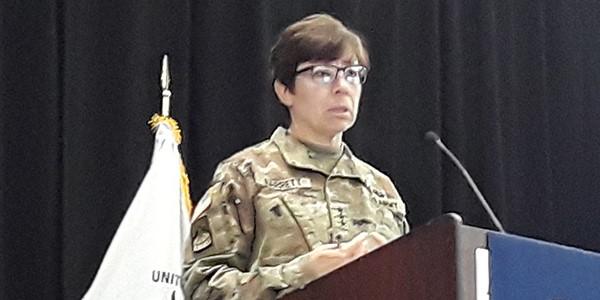Army Mastering Fusion of Cyber and Electronic Warfare
The U.S. Army is seeing a successful integration of cyber operations and electronic warfare operations but could more effectively add information operations to the mix, according to Lt. Gen. Maria Barrett, USA, commander, Army Cyber Command.
In her first public speaking engagement since taking charge at Army Cyber Command, Gen. Barrett offered the morning keynote speech at the AFCEA Cyber Education, Research and Training Symposium (CERTS) on May 11 in Augusta, Georgia.
She described continuing instability across the world, citing the war in Ukraine as an example. Meanwhile, the United States is being challenged by adversaries “seeking to achieve their strategic gains across the spectrum” but “beneath the level of armed conflict” and “using layered standoff in a political, military and economic dimensions to separate us from our partners,” she reported.
Those operations offer a glimpse of the warfare of tomorrow. “This is the battlefield of the future where we have to gain a greater understanding. Take a look at the operations we’ve been conducting since our [Army Cyber Command’s] inception. We’re starting to see the fusion of cyber operations with electronic warfare operations coming to fruition in a repeatable fashion. I think we’re starting to master this piece,” she said.
LTG Maria Barrett, USA, commander, Army Cyber Command: You have to put your money where your mouth is, and I believe the Army has done that. We've always valued people.#CERTS
— George Seffers (pronounced See furs) (@gseffers) May 11, 2022
While information has been applied, she added, integrating it seems to be “a little bit more difficult.” The service needs to pay attention and “get the information operations a little bit closer to how we’re fusing cyber and electronic warfare together.”
Barrett discussed needs the Army should address for professional personnel in the realms of cyber-electromagnetic activities (CEMA), information operations and intelligence. For CEMA professionals, she suggested the Army assess ways to build an environment that allows those personnel to “be sustained over the life of their career.”
That starts with a basic understanding of the technology and “looking at their adaptability to apply and advance their own learning.”
While continuing professional development is important, it doesn’t always require formal training. “It is part of the equation to give our workforce formal training in the emerging technologies that are necessary to either sustain the networks that our warfighters operate off of or to attack, but I think there are other ways to doing it as well. Let’s not forget some experiential opportunities that are out there.”
Possibilities include allowing someone from a regional cyber center to work for one year with the Enterprise Cloud Management Agency, for example. “It doesn’t have to be formal cloud training. It doesn’t have to be training with industry, with Microsoft Azure. The opportunities are there both for our military and civilians, and let’s not forget teleworkers.”
The commander questioned whether the Army is currently preparing leaders to make effective data-based decisions. “We could probably give some options, but I’m not sure in all cases we’ve postured our leaders to make decisions off of the data that we’re giving them. Our exercise constructs may not lend themselves to this,” she offered.
LTG Maria Barrett, USA, commander, Army Cyber Command: We know that we will be operating in a contested environment. Are we equipping our forces to do that?#CERTS
— George Seffers (pronounced See furs) (@gseffers) May 11, 2022
The National Training Center is beginning to inject some ability to train leaders in controlled environments on the capability during Brigade Combat Team Evaluations, but “We’ve got to get this at all echelons.”
Speed may be the most vital element when it comes to winning information operations. “Whether truth or disinformation prevails in the operational environment is largely determined by speed. It is the determining factor in the information dimension,” she declared.
Gen. Barrett cited a study that indicated the human ability to discern truth from fiction on the Internet is “incredibly limited.” The study showed that men can recognize the truth only 51 percent of the time, women 52 percent. “They were flipping a coin in their ability to discern the truth,” she said, adding that widely sharing information caused people to believe it to be true. “This is where the speed factor comes in. First to the fight in the information realm has a better chance of having their narrative prevail.”
She also suggested the Army could benefit from programs such as the University of Arizona cyber operations program that has created 1,500 digital personalities with growing relationships. “You can test out your policies and your activities and see what is going to take place. Those types of virtual environments where you can do that, those types of rehearsals and understanding what’s effective offer opportunities for us,” Gen. Barrett said.
For intelligence professionals, the Army needs to challenge assumptions about the types of intelligence that can be useful. “We are definitely super consumers of the traditional intelligence we need in order to do our operations. But we’ve challenged the status quo in terms of that being the only thing that we use,” the general asserts.
Ideally, intelligence professionals would take advantage of open source intelligence, commercially occurring information and publicly available information, enrich that information and provide insights, possibly faster than they could with traditional intelligence sources, she suggested. “One doesn’t have to look any further than what is happening in the Ukraine, and what organizations or communities of interest like Bellingcat are doing,” she added. She described Bellingcat as a community of interest “with all of that publicly available information and a methodology by which to parse through it and draw conclusions from it faster and pretty darn accurate” and questioned how the Army might integrate that ability into its own intelligence operations.






Comments